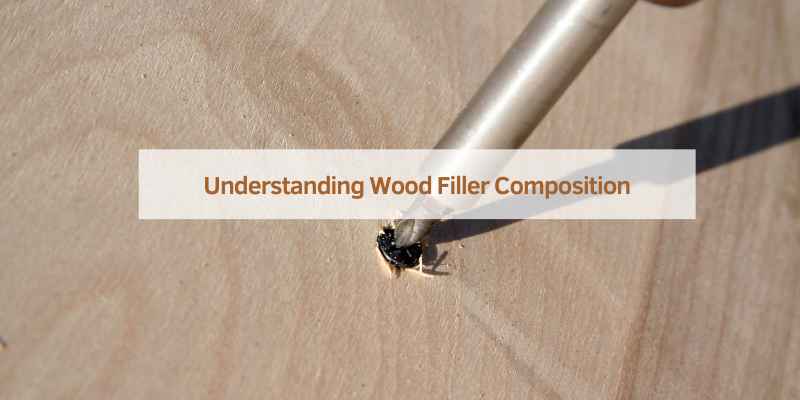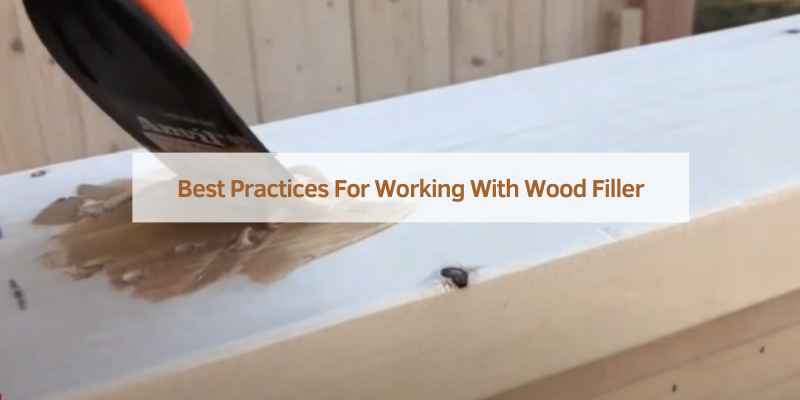Yes, you can screw into wood filler. Wood filler is a versatile material that can be used to fill holes, cracks, and gaps in wood surfaces.
It dries hard and can be sanded, painted, or stained, making it suitable for various woodworking projects. When using wood filler, it’s important to ensure that it is fully cured before attempting to screw into it to avoid any cracking or damage.
Additionally, selecting a high-quality wood filler and following proper application and drying procedures will result in a strong and durable surface for screwing into. Understanding the characteristics of wood filler and its compatibility with screws will help you achieve the desired results in your woodworking projects.
Understanding Wood Filler Composition
Wood fillers are essential for fixing imperfections in wood surfaces. Understanding the composition of wood fillers is crucial for achieving the desired results.
Types Of Wood Fillers
- Water-Based Wood Fillers
- Solvent-Based Wood Fillers
- Epoxy Wood Fillers
Ingredients Of Wood Fillers
| Component | Function |
|---|---|
| Cellulose | Provides bulk and structure |
| Pigments | Coloration and UV protection |
| Resins | Adhesion and durability |

Properties Of Wood Filler
When it comes to repairing wood surfaces, wood filler is a versatile and essential product. It is commonly used to fill gaps, cracks, and holes in wood, providing a smooth and uniform surface for painting or staining. Understanding the properties of wood filler, such as hardening time and shrinkage rate, is crucial for achieving the desired results in woodworking projects.
Hardening Time
The hardening time of wood filler varies based on the type and brand. Some wood fillers harden in as little as 15 minutes, while others may take several hours to cure completely. Choosing a wood filler with a quick hardening time can expedite the repair process, especially for projects with time constraints.
Shrinkage Rate
Shrinkage rate refers to the amount of volume reduction that occurs as the wood filler dries and cures. High-quality wood fillers are formulated to have minimal shrinkage, ensuring that the repaired area maintains its integrity without unsightly cracks or gaps. Opting for a wood filler with low shrinkage rate is essential for achieving a seamless and durable finish.
Can You Screw Into Wood Filler?
Yes, you can screw into wood filler, but it’s not as strong as wood. Pre-drilling may help hold the screw better. Make sure the filler is fully dried before screwing.
Factors To Consider
When it comes to screwing into wood filler, there are a few important factors to consider. First and foremost, you need to assess the type and quality of the wood filler you are using. Not all wood fillers are created equal, and some may not be suitable for screw insertion. It is crucial to choose a high-quality wood filler that is specifically designed to withstand the pressure and stress of screws.
Another factor to consider is the depth of the screw insertion. The depth should be appropriate to ensure a secure hold without compromising the integrity of the wood filler. If the screw is inserted too shallow, it may not provide enough stability. On the other hand, if it is inserted too deep, it may weaken the wood filler and cause it to crack or break.
The composition of the wood filler is also important. Some wood fillers contain additives or fibers that can affect the screw’s grip. It is recommended to check the manufacturer’s instructions or consult an expert to ensure compatibility between the wood filler and the screws you plan to use.
Tips For Proper Screw Insertion
To ensure proper screw insertion into wood filler, follow these tips:
1. Pre-drill holes: Pre-drilling pilot holes can help prevent the wood filler from cracking or splitting when the screw is inserted. The size of the pilot hole should be slightly smaller than the diameter of the screw to provide a snug fit.
2. Use the right screws: Choose screws that are appropriate for the project and compatible with the wood filler. Consider factors such as length, diameter, and head type to ensure a secure and sturdy hold.
3. Apply pressure gradually: When inserting the screw, apply gentle and even pressure to avoid putting excessive stress on the wood filler. This will help prevent cracking or breaking.
4. Avoid over-tightening: Be cautious not to over-tighten the screws, as this can weaken the wood filler or strip the threads. Tighten the screws until they are snug, but avoid excessive force.
Remember, the success of screwing into wood filler depends on the quality of the filler, proper preparation, and careful execution. By considering these factors and following the tips mentioned above, you can achieve a secure and durable connection when working with wood filler and screws.
Alternatives To Screwing Into Wood Filler
When it comes to working with wood filler, there are times when you may need to explore alternatives to screwing into it. While wood filler is great for filling holes and cracks in wood, it may not always provide the necessary support for screws, especially in load-bearing applications. In such cases, it’s essential to consider alternative methods for securing items to wood filler.
Using Anchors
One alternative to screwing into wood filler is to use anchors. Anchors provide a secure way to attach items to wood filler, offering stability and strength. There are various types of anchors available, including expansion anchors, toggle bolts, and screw anchors, each designed for specific applications. By using anchors, you can effectively secure items to wood filler without compromising stability.
Utilizing Brackets Or Supports
Another effective alternative to screwing into wood filler is to utilize brackets or supports. Brackets and supports provide a sturdy and reliable means of attaching items to wood filler, distributing weight and reducing strain on the filler. Whether it’s shelf brackets, corner braces, or L-shaped supports, incorporating these hardware elements can offer the necessary reinforcement without relying solely on the wood filler for support.
Common Mistakes To Avoid
When it comes to working with wood filler, it’s important to be aware of the common mistakes that can occur. By avoiding these mistakes, you can ensure that your screws are securely fastened and your project is built to last.
Over-tightening Screws
Over-tightening screws is a common mistake that can lead to problems down the line. When you tighten a screw too much, it can cause the wood filler to crack or break, compromising the integrity of your project. To avoid this, be sure to use a screwdriver or drill with a clutch or adjustable torque setting. This will allow you to control the amount of force applied, preventing over-tightening and potential damage.
Using Incorrect Screw Size
Using the incorrect screw size is another mistake that can affect the durability of your project. If the screw is too short, it may not penetrate the wood filler deep enough to provide a secure hold. On the other hand, if the screw is too long, it can create an uneven surface or even poke through the other side of the material. To avoid these issues, always choose screws that are the appropriate length for the thickness of your wood and the depth of the hole.
By being aware of these common mistakes and taking the necessary precautions, you can ensure that your screws are properly secured into wood filler, providing a strong and reliable connection for your woodworking projects.
Best Practices For Working With Wood Filler
When it comes to working with wood filler, one common question is whether you can screw into it. While it is possible to do so, it’s important to ensure that the wood filler has fully cured and hardened before attempting to screw into it.
Additionally, using longer screws and drilling pilot holes can help to avoid any cracking or splitting of the wood filler.
Wood filler is a versatile material that can be used to repair cracks, holes, and other imperfections in wood surfaces. But can you screw into wood filler? The answer is yes, but there are some best practices you should follow to ensure a strong and durable repair.
Preparation Steps
Before you begin working with wood filler, it’s important to properly prepare the surface you’ll be repairing. This involves cleaning the area to remove any dust, dirt, or debris, and sanding the surface to create a rough texture that the wood filler can adhere to.
Once the surface is clean and properly sanded, you can begin applying the wood filler. But before you do, it’s a good idea to have all of your tools and materials ready to go, including a putty knife, sandpaper, and any paint or stain you’ll be using to finish the repair.
Application Techniques
When applying wood filler, it’s important to follow the manufacturer’s instructions carefully. This may involve mixing the filler with a hardener or other additive, or simply applying it directly from the container.
Regardless of the application method you choose, it’s important to apply the wood filler evenly and in thin layers, allowing each layer to dry completely before applying the next. This will help ensure a strong and durable repair that won’t crack or shrink over time.
Once the wood filler has fully cured, you can sand it down to create a smooth, even surface that’s ready for painting or staining. And when it comes time to screw into the wood filler, be sure to use the appropriate size and type of screw for the job, and pre-drill the hole to prevent splitting or cracking.
In conclusion, by following these best practices for working with wood filler, you can create strong and durable repairs that will stand the test of time. Whether you’re fixing a small crack or a large hole, taking the time to properly prepare the surface and apply the filler evenly will ensure a successful outcome every time.

Frequently Asked Questions
Can Wood Filler Be Drilled Into?
Yes, wood filler can be drilled into once it has fully dried. It provides a sturdy surface for drilling and holding screws securely in place.
Is Wood Filler Strong Enough For Screws?
Wood filler can be strong enough for screws, depending on the type and application. For heavy-duty projects, it’s recommended to use a wood filler specifically designed for screw-holding strength.
How Long Does Wood Filler Take To Harden?
The drying time of wood filler varies based on the brand and type used. Typically, it takes around 2 to 8 hours to harden fully, but it’s advised to wait at least 24 hours before drilling or screwing into it.
Can Wood Filler Hold Screws Securely?
When applied correctly and allowed to fully dry, wood filler can hold screws securely by providing a solid anchor point. It’s essential to follow the manufacturer’s instructions for the best results.
Conclusion
Screwing into wood filler is possible with proper preparation and technique. It’s important to use the right tools and methods for a successful outcome. Understanding the limitations and strengths of wood filler will help you achieve the desired results in your woodworking projects.


